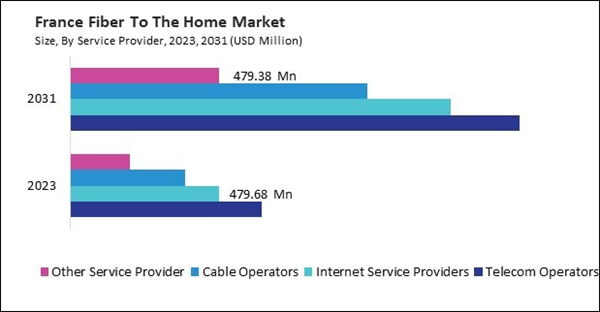The Germany market dominated the Europe Fiber To The Home Market by country in 2023, and is expected to continue to be a dominant market till 2031; thereby, achieving a market value of $6.48 billion by 2031. The UK market is exhibiting a CAGR of 10.4% during 2024-2031. Additionally, the France market is expected to experience a CAGR of 12.3% during 2024-2031.
Employees require high-speed, reliable internet to access company networks, participate in virtual meetings, and collaborate on cloud-based projects without disruptions. FTTH networks provide bandwidth and stability, ensuring that remote workforces remain productive and efficient. Moreover, the adoption of smart home technologies - including connected security cameras, smart thermostats, and voice assistants - has further driven the need for robust broadband infrastructure.
Another crucial factor driving market growth is the rollout of 5G networks, which rely on fiber-optic backhaul for optimal performance. Unlike previous wireless technologies, 5G requires ultra-fast, low-latency connectivity to support high-speed data transmission across dense network infrastructures. Telecom operators are expanding fiber-optic networks to connect 5G small cells, base stations, and edge computing nodes, ensuring that mobile networks can handle increasing traffic loads. FTTH deployments also contribute to developing hybrid fiber-wireless solutions, where fiber backhaul enhances the speed and reliability of 5G connectivity. As the demand for autonomous vehicles, industrial automation, and cloud-based applications continues to escalate, the integration of 5G technology with fiber-optic networks will be instrumental in defining the future landscape of wireless communication.
Italy is witnessing a significant surge in FTTH adoption, particularly due to government-led rural broadband initiatives and the need for 5G backhaul infrastructure. The Piano BUL (Ultra-Broadband Plan), spearheaded by the Italian government, is focused on closing the digital divide in rural and underserved areas. Public funding and EU grants support fiber rollouts in remote regions, ensuring businesses and households can access ultra-fast broadband. Additionally, 5G network expansion is increasing demand for fiber-optic backhaul, with companies like TIM (Telecom Italia), Open Fiber, and Fastweb investing in integrated FTTH and 5G deployments to support the country’s digital transformation strategy. Thus, as demand for digital services, AI, IoT, and smart cities grows, Europe is positioning itself as a global leader in FTTH adoption, fostering a highly connected, efficient, and competitive digital economy.
List of Key Companies Profiled
- AT&T Inc.
- Verizon Communications, Inc.
- Singtel (Temasek Holdings (Private) Limited)
- Frontier Communications Parent, Inc.
- ZTE Corporation
- Deutsche Telekom AG
- Vodafone Group Plc
- Orange S.A.
- Huawei Technologies Co., Ltd. (Huawei Investment & Holding Co., Ltd.)
- Nokia Corporation
Market Report Segmentation
By Product
- More than 1 Gbps
- 50 to 100 Mbps
- 100 Mbps to 1 Gbps
- Less than 50 Mbps
By Service Provider
- Telecom Operators
- Internet Service Providers
- Cable Operators
- Other Service Provider
By Application
- VoIP
- Internet TV
- Remote Education
- Smart Home Application
- Interactive Gaming
- Virtual Private LAN Service
- Other Application
By Country
- Germany
- UK
- France
- Russia
- Spain
- Italy
- Rest of Europe
Table of Contents
Companies Mentioned
- AT&T Inc.
- Verizon Communications, Inc.
- Singtel (Temasek Holdings (Private) Limited)
- Frontier Communications Parent, Inc.
- ZTE Corporation
- Deutsche Telekom AG
- Vodafone Group Plc
- Orange S.A.
- Huawei Technologies Co., Ltd. (Huawei Investment & Holding Co., Ltd.)
- Nokia Corporation
Methodology

LOADING...









